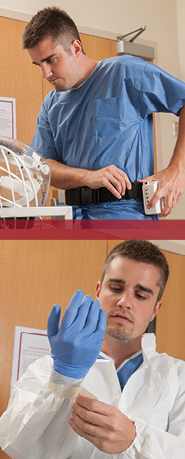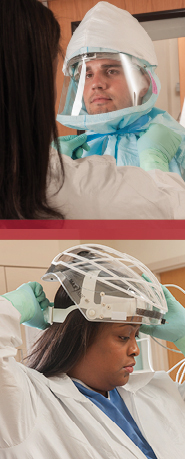Test of Skill, Test of Faith
By Pam Auchmutey

Laura Mitchell (left), Crystal Johnson (top middle), and Jason Slabach (right)
The image is iconic. As news helicopters hover overhead, physician Kent Brantly, clad head to toe in white protective gear, steps out of an ambulance and slowly enters Emory University Hospital to become the first patient treated for Ebola hemorrhagic fever on American soil. He contracted the Ebola virus while serving as a medical missionary in Liberia.
Crystal Johnson 00N felt a sense of relief when she watched the news coverage on TV last August. The fact that Brantly could walk with assistance into the hospital was a good sign, she thought.
That night, when she began her shift in the hospital's special isolation unit, she realized her patient's condition was grave. "I could see he was really sick," says Johnson, who suited up in full personal protection equipment (PPE) to care for Brantly in four-hour stints. "Every hour, we were all on edge because he was decompensating quickly."
|
|
Though the situation was intense, the team of nurses and physicians in Emory's Serious Communicable Disease Unit (SCDU) knew what to do. Their skills and training kicked in to restore Brantly to health, as they would do for three more Ebola patients, including an American from Sierra Leone and a nurse from Dallas, Texas.
Eight years earlier, Johnson had volunteered to help staff the isolation unit while working in the cardiovascular surgery ICU at Emory University Hospital Midtown. Built in 2002, the SCDU stood ready to isolate CDC staff exposed to highly contagious pathogens in the line of duty.
"All I could think of was the movie Outbreak. I wanted to dress up in that white suit," says Johnson of her decision to volunteer. "The unit was at Emory Hospital, just down the street from the CDC. I just wanted to get started. It was exciting."
She convinced Laura Mitchell 95OX 97N to join her. "Crystal said it was a great opportunity—give it a try," recalls Mitchell, who staffs the same unit at Emory Midtown. "That's the great thing about nursing. You can try many different things."
Since then, the two Emory nursing alumni have trained yearly with other clinicians to work as needed in the SCDU. Last August, the unit was activated to receive its first Ebola patients—Brantly, followed by fellow aid worker Nancy Writebol three days later.
Things ratcheted up quickly the day before Brantly arrived. Unit clinicians received upgraded protective gear and more training. Most important, they learned to carefully don and doff their full PPE to prevent exposure to the Ebola virus and watch out for one another to prevent potentially deadly mistakes.
"In nursing, we're taught that patient and family come first," says Johnson, now a post-anesthesia care unit nurse at Emory Midtown. "That day, the priority was our safety. The training was intense, like in the military. They tested us to see if we would crack under pressure."
Adds Mitchell, "That's how our team became a family in one afternoon."
Taking care of one's own
Jason Slabach 13N learned the donning and doffing procedure by heart like the rest of his "kin." The steps were familiar to him, since he had worked with different levels of PPE as a paramedic in Virginia before following his future wife to nursing school at Emory. When Slabach joined Emory Hospital's cardiovascular ICU in 2013, he had no idea he would help care for the first Ebola patients in the U.S., let alone be among the Ebola fighters named by Time magazine as its 2014 Person of the Year. He was asked to join the SCDU to ramp up the staffing needed for the Ebola patients' care.
"I was very glad they brought Dr. Brantly to Emory," says Slabach. "He's an American citizen, and I'm a believer in taking care of our own. And he's a health care worker and a missionary. I wanted to support that."
The nurses and physicians in the SCDU bonded quickly with their patients, who had no physical contact with the outside world. The unit comprises two ICU hospital rooms separated by an anteroom. Generally, three nurses staff the unit at a time. One nurse is dedicated per patient, while a third nurse observes them from the anteroom. With staffing at a minimum to prevent contamination, each nurse must assume multiple roles.
"We had to be the physical therapist. We had to be the respiratory therapist. We were housekeeping. We had to be everything for that patient," says Johnson.
Most important, each nurse provided supportive care to maintain vital functions that enable the patient's immune system to fight the virus and recover. As the SCDU team quickly learned, replacing fluids and electrolytes lost primarily through vomiting and diarrhea was key to their patients' recovery. Other treatments such as blood transfusions and experimental drugs were given in hopes of ensuring their survival.
"Coming from the critical care environment, we're used to caring for very sick patients and constantly looking for changes, constantly watching our patients," says Mitchell. "It was very easy to transfer those skills into this type of setting."
Caring for the Ebola patients underscored the importance of following nursing protocols, both in the isolation unit and in the regular units where Mitchell, Johnson, and Slabach work. During nursing school, the course on the nursing process was Johnson's least favorite. "I'm never going to use this," she thought at the time. But in the SCDU with an Ebola patient, the importance of this theory quickly became apparent.
"We had to look at what our patients needed besides medication," Johnson explains. "We had to go back to the nursing process to look at them as a whole—mind, body, and spirit. We had to evaluate their needs from all aspects and be everything to them."
It also reminded nurses to think more carefully about basic steps easily taken for granted.
"We take off our gloves 10,000 times a day or week. But now we think about how we take off those gloves," Mitchell says.
|
|
A family grows
When an Ebola patient is in the isolation unit, team members attend "family" meetings every morning to review standard operating protocols and discuss successes, mistakes, and lessons learned.
"It's probably the healthiest environment I've worked in where critique is encouraged because we are all in this together," says Slabach. "Any mistake I make not only affects me but also my co-workers and their loved ones. We also check our temperature and record our symptoms twice a day. We make sure we all do that."
The nurse-physician relationship grew stronger as they learned from the process of treating the first Ebola patients in the Western Hemisphere. "Nurses are used to doctors telling them what to do," Johnson says. "But sometimes people forget what nurses really do. A patient might grab us, hold onto us, or get things on us. We aren't working in a controlled setting. We became more confident in telling the physicians what did and didn't work. They would listen and say, 'OK, let's try this instead.' "
Team members remained vigilant of their patients' morale. To buoy Writebol's spirits, Mitchell turned off the TV in her room to block out Ebola news coverage. As Brantly improved, Slabach played Nerf basketball with him and discussed their faith and a mutual friend in Liberia. All of the nurses listened as their patients shared stories about family, work, and life experiences. The nurses' spirits soared when their patients felt well enough to eat a meal and take a shower.
"Listening to Nancy made me a stronger person," says Mitchell. "She's been a missionary for over 20 years. Her family is amazing. They are unconditional in their faith. I found that very inspiring."
The Emory nurses formed a different bond with their fourth patient, nurse Amber Vinson, who contracted Ebola while treating a patient from Liberia at Texas Health Presbyterian Hospital in Dallas.
"Although she worked in a different state and under slightly different circumstances, I felt like she and her colleagues were one of our own," says Johnson. "It made me think about how I would handle it if someone from our team fell ill. We were able to discuss and compare feelings about this crisis on a level that only those who walk this road would understand."
When Brantly and Writebol arrived at Emory, Mitchell at first didn't tell her family where she was working. She didn't want them to worry. But the cat was out of the bag when family members and friends spotted her on TV during a press conference when Brantly was discharged from Emory.
"You come from a good background and a good foundation," Mitchell's fans told her afterward. "We don't expect anything less of you."
Shortly before the press conference began, Johnson watched Brantly step out of the isolation unit for the first time and hug his wife, who placed his wedding band back on his left ring finger.
"When they walked down the hall together hand-in-hand, it was like they had gotten married all over again," Johnson says. "It was beautiful."
LEARN MORE:Watch Crystal Johnson, Laura Mitchell, and Jason Slabach talk about caring for Ebola patients at Emory in the video: Also watch them during a recent panel discussion at the School of Nursing: |


